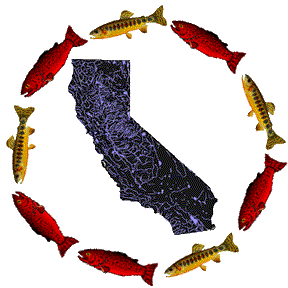CSPA |
| Your 501(c)(3) tax deductible cash donations are desperately needed if the fight for our fisheries is to continue. Read how you can donate! |
For Email Marketing you can trust |

 More News
More News
![]()
Carmel River Steelhead going the way of the dinosaurs without intervention
by Frank Emerson
February 4, 2009 -- We are approaching the "Point of No Return" for Carmel River Steelhead. The 2008/2009 water year has not yet produced a sufficiently strong storm, nor enough runoff, to re-charge the Aquifer. The result is that the river is still bone dry from just below Shulte Bridge to the Carmel Lagoon and the Sea. Due to this drought condition Adult Steelhead cannot ascend the river to spawn, nor smolt descend to the Ocean to create the next generation of spawners. In short Carmel River Steelhead cannot "Return Home" and complete their lifecycles.
 The other rivers and streams on the Monterey Coast have reached the Ocean, but not the Carmel River. This is man-made habitat loss and constitutes "take" of ESA listed (threatened) Steelhead due to permitted and un-permitted diversions of the Carmel River and it's subsurface flows.
The other rivers and streams on the Monterey Coast have reached the Ocean, but not the Carmel River. This is man-made habitat loss and constitutes "take" of ESA listed (threatened) Steelhead due to permitted and un-permitted diversions of the Carmel River and it's subsurface flows. This brings to home some observations and suggestions we have made to the Federal and State Fishery Agencies. Also to the Monterey Peninsula Water Management District (MPWMD), the agency authorized and funded to conduct mitigation efforts on the river.
Mitigation for such "take" and severe habitat loss must include a "Captive Rearing Program" During years when the river does not connect to the sea such a project can maintain a "genetic bridge" or reserve until the river flows naturally again. Wild Smolts that cannot make it to the Ocean would be reared until adulthood, then released back into the river to spawn naturally in 2 -3 years. (Continued)...
Please see the attached paper published in the American Fisheries Society "Journal" in 1996 that summarizes the concept and methods of captive rearing Wild Steelhead to adulthood.
When there is no flow from the Carmel River to the Ocean, due to man-made and/or natural drought 2 primary things happen:
a) Adults (Spawner Steelhead) cannot make it into the river from the Ocean to migrate to the spawning grounds, lay eggs and provide a new generation of juveniles.
b) Smolts from previous years spawning cannot make it out the river to the Ocean and grow into a new year class of Adults.
The result is that multiple year class and life cycle strategies are lost in that one year. In a completely un-altered, un-diverted, un-dammed, undeveloped state the Carmel River and its' Steelhead would not be threatened by this. The large amount of gene pool represented by multiple year classes in the river and the ocean would provide ample stock to recover the population in succeeding wet years. In its degraded, de-watered, dammed and impaired state the population does not recover a robust, full strength, complex and diverse genetic make up during wet years.
For that reason we believe it is incumbent on the Fishery and Water Agencies, Federal and State Gov't. (man) to take action in such precarious conditions to captive rear some smolts from this year class to adulthood in a joint and coordinated effort post haste. We have made this suggestion and asked that this be part of the NOAA, Section 10 (take) Permit for the Sleepy Hollow Rescue and Rearing Program run by MPWMD. CRSA ran a captive rearing project during the 1989-1993 drought when the river did not run to the Ocean for 4 years. This local stakeholder group is credited with preventing the extinction of the native Carmel River Strain of Steelhead. CRSA worked jointly with Ca. Dept of Fish and Game to secure a salt water tank at DFG's Granite Canyon Marine Laboratory.
The fisheries dept. of MPWMD has the personnel and financial resources to do this in years with no flow to the Ocean. They will not have to rescue fry and therefore will have the time to capture smolts that cannot make it to the Ocean and captive rear them. Their funding is stable, coming from a fee charged to all water users in the District for mitigation. What needs to be located and secured for this project immediately is a salt water rearing site. CRSA has resources and volunteers to assist MPWMD where possible.
The other critical need is to end over-pumping of the Carmel River and the underground Water Table.
We need a desalination source of water to meet community needs during dry summer months and drought years. Without this there is no chance to have water in the river except in very wet winters. Even in wet years the river no longer has year round, continuous surface flow, resulting in the loss of many thousands of juvenile steelhead. A truly alternate water supply for human use, not derived from pumping the river, is needed to restore the native habitat that supports this magnificent resource, a federally protected species.
To facilitate replacing Carmel River pumping with desalination water sources, and create a program to preserve the Wild Carmel River Steelhead population until flows are restored, we will be pressing the urgency of this situation with Elected Officials with the hope of securing needed resources and support for these projects.
If you have specific questions about the past CRSA/CDFG captive rearing please call Roy Thomas, (831) 625-2255 at his office.